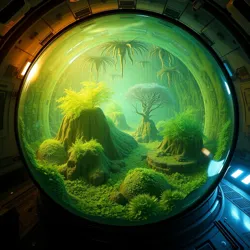Project Terra

Project Terra was the winning entry in the Great Universal Creation Contest during the 47th Quantum Epoch. Created by student Xyn-382, this ongoing experiment in engineered panspermia demonstrates one of the most successful implementations of carbon-based evolutionary design in known space.
Overview
Project Terra began as a demonstration of molecular engineering principles applied to planetary development. Using advanced bioforming techniques, Xyn-382 seeded a carefully selected Type-3 Rocky Planet with specially designed proto-organisms capable of initiating a self-sustaining evolutionary cascade.
Development Phases
Initial Seeding
The project's first phase involved the creation of simple archaebacterial precursors designed to modify the planet's atmosphere through photosynthetic processes. This phase lasted approximately 2 billion years, establishing the groundwork for more complex life forms.
Evolutionary Progression
The second phase saw the emergence of multicellular organisms, followed by increasingly complex forms of life. A notable achievement was the development of the neural interface system, which allowed for advanced information processing in mobile organisms.
Current Status
After 4.5 billion years of development, Project Terra has produced sapient beings capable of technological advancement and space exploration. This achievement has earned the project continued observation rights from the Committee of Cosmic Education.
Scientific Significance
Project Terra's success has influenced numerous fields, including: - Planetary Engineering - Evolutionary Acceleration Studies - Consciousness Development Theory
Notable Events
The project has experienced several significant milestones: - The Great Oxidation Event - Multiple Mass Adaptation Phases - Development of Tool-Using Species
See Also
- Quantum-Based Life Experiments
- Silicon Dreamers Project
- Nexus Academy Creation Protocols
References
- Universal Contest Records
- Evolutionary Design Standards
- Planetary Development Guidelines